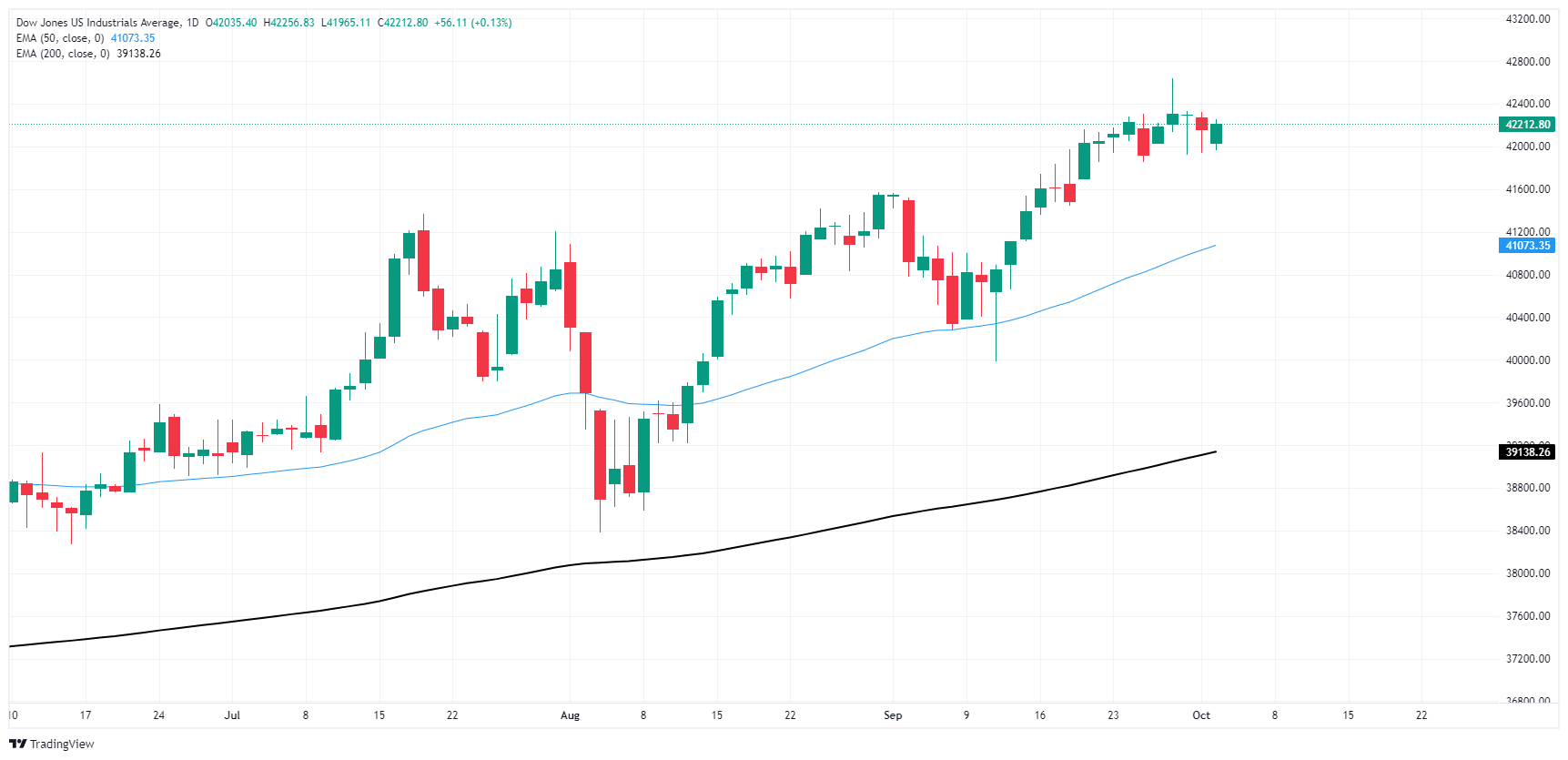Dow Jones weighed down by broad market risks

- Dow Jones catches chart friction near 42,200 as investors waver.
- Precursor jobs data to Friday’s upcoming NFP surprised to the upside.
- Geopolitical concerns cap gains as investors pivot to watching the Middle East.
The Dow Jones Industrial Average (DJIA) is caught in a bit of a sideways trap in the first week of October as geopolitical concerns weigh on risk appetite. Investors are jostling for position ahead of Friday’s bumper print of US Nonfarm Payrolls (NFP) jobs data with future rate moves from the Federal Reserve (Fed) potentially riding on labor figures.
US ADP Employment Change figures for September rose higher and faster than most market participants expected, clocking in at 143K net new job additions over the month. Median markets forecasts called for a jump to 120K compared to August’s revised print of 103K. Despite the firm upshot in advance jobs numbers, investors will be waiting for the final call on official advance figures on NFP Friday.
Fed Chair Jerome Powell warned that September’s outsized 50 bps rate cut shouldn’t be a signal that further extreme rate moves are on the way. The Fed’s own SEP outlook on rate cuts sees only another 50 bps in total over the next few meetings. Rate markets have fallen in-line with the Fed’s own outlook for the most part; according to the CME’s FedWatch Tool, rate traders see 60% odds of a follow-up 25 bps rate cut in November, with the remaining 40% still hoping for a repeat jumbo cut for 50 bps.
On top of the global market’s outlook on Fed rate cuts, the outlook on domestic manufacturing has evolved into a shaky prospect with a port worker strike across most of the East and Gulf Coasts hampering the movement of physical goods. Middle East tensions are also spilling over following Iran’s missile strike against Israel in retaliation for Israel’s incursion into Lebanon recently. Investors are waiting to see how Israel will respond to the direct confrontation.
Dow Jones news
Despite a wobbly start to the US market session, the Dow Jones is testing into the green on Wednesday. The midweek trading window has the DJIA roughly equally-balanced, with around half of the index’s constituent securities rising for the day. Salesforce (CRM) is rebounding from a recent plunge, climbing 4% on Wednesday to test $282 per share.
On the low end, Nike (NKE) has extended a near-term plunge, sinking over 6% and backsliding to under $84 per share as the shoe manufacturer battles a gloomy outlook. Nike reported a wide miss of earnings expectations in the first quarter of 2024, and the company’s CEO transition has rattled investors.
Dow Jones price forecast
The Dow Jones is in a rough technical consolidation zone between 42,400 and 42,200 on daily candlesticks as buyers grapple with an index planted far too deep into bull country with little technical rebound. The Dow Jones’ last swing low into the 40,000 handle in early September and subsequent 6.6% bottom-to-top rally has left price action in overbought territory, and short pressure will be looking for a snap back to the 50-day Exponential Moving Average (EMA) rising into 41,100.
Dow Jones daily chart
Fed FAQs
Monetary policy in the US is shaped by the Federal Reserve (Fed). The Fed has two mandates: to achieve price stability and foster full employment. Its primary tool to achieve these goals is by adjusting interest rates. When prices are rising too quickly and inflation is above the Fed’s 2% target, it raises interest rates, increasing borrowing costs throughout the economy. This results in a stronger US Dollar (USD) as it makes the US a more attractive place for international investors to park their money. When inflation falls below 2% or the Unemployment Rate is too high, the Fed may lower interest rates to encourage borrowing, which weighs on the Greenback.
The Federal Reserve (Fed) holds eight policy meetings a year, where the Federal Open Market Committee (FOMC) assesses economic conditions and makes monetary policy decisions. The FOMC is attended by twelve Fed officials – the seven members of the Board of Governors, the president of the Federal Reserve Bank of New York, and four of the remaining eleven regional Reserve Bank presidents, who serve one-year terms on a rotating basis.
In extreme situations, the Federal Reserve may resort to a policy named Quantitative Easing (QE). QE is the process by which the Fed substantially increases the flow of credit in a stuck financial system. It is a non-standard policy measure used during crises or when inflation is extremely low. It was the Fed’s weapon of choice during the Great Financial Crisis in 2008. It involves the Fed printing more Dollars and using them to buy high grade bonds from financial institutions. QE usually weakens the US Dollar.
Quantitative tightening (QT) is the reverse process of QE, whereby the Federal Reserve stops buying bonds from financial institutions and does not reinvest the principal from the bonds it holds maturing, to purchase new bonds. It is usually positive for the value of the US Dollar.
